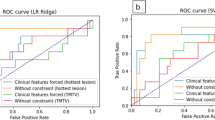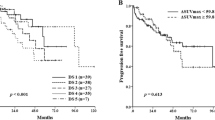Abstract
We conducted a retrospective analysis of 50 lymphoma patients (Hodgkin's disease and non-Hodgkin's lymphoma) who had an 18F-fluoro-deoxyglucose positron emission tomography (FDG-PET) scan after at least two cycles of salvage chemotherapy and before autologous stem cell transplantation (ASCT) at our institution. The patients were categorized into FDG-PET negative (N=32) and positive (N=18) groups. The median follow-up after ASCT was 19 months (range: 3–59). In the FDG-PET-negative group, the median progression-free survival (PFS) was 19 months (range: 2–59) with 15 (54%) patients without progression at 12 months after ASCT. The median overall survival (OS) for this group was not reached. In the FDG-PET-positive group, the median PFS was 5 months (range: 1–19) with only one (7%) patient without progression at 12 months after ASCT. The median OS was 19 months (range: 1–34). In the FDG-PET-negative group, chemotherapy-resistant patients by CT-based criteria had a comparable outcome to those with chemotherapy-sensitive disease. A positive FDG-PET scan after salvage chemotherapy and prior ASCT indicates an extremely poor chance of durable response after ASCT.
This is a preview of subscription content, access via your institution
Access options
Subscribe to this journal
Receive 12 print issues and online access
$259.00 per year
only $21.58 per issue
Buy this article
- Purchase on Springer Link
- Instant access to full article PDF
Prices may be subject to local taxes which are calculated during checkout

Similar content being viewed by others
References
Fisher RI, Gaynor ER, Dahlberg S, Oken MM, Grogan TM, Mize EM et al. Comparison of a standard regimen (CHOP) with three intensive chemotherapy regimens for advanced non-Hodgkin's lymphoma. N Engl J Med 1993; 328: 1002–1006.
Bonadonna G, Zucali R, Monfardini S, De Lena M, Uslenghi C . Combination chemotherapy of Hodgkin's disease with adriamycin, bleomycin, vinblastine, and imidazole carboxamide versus MOPP. Cancer 1975; 36: 252–259.
Philip T, Armitage JO, Spitzer G, Chauvin F, Jagannath S, Cahn JY et al. High-dose therapy and autologous bone marrow transplantation after failure of conventional chemotherapy in adults with intermediate-grade or high-grade non-Hodgkin's lymphoma. N Engl J Med 1987; 316: 1493–1498.
Philip T, Guglielmi C, Hagenbeek A, Somers R, Van der Lelie H, Bron D et al. Autologous bone marrow transplantation as compared with salvage chemotherapy in relapses of chemotherapy-sensitive non-Hodgkin's lymphoma. N Engl J Med 1995; 333: 1540–1545.
Ferme C, Mounier N, Divine M, Brice P, Stamatoullas A, Reman O et al. Intensive salvage therapy with high-dose chemotherapy for patients with advanced Hodgkin's disease in relapse or failure after initial chemotherapy: results of the Groupe d'Etudes des Lymphomes de l'Adulte H89 Trial. J Clin Oncol 2002; 20: 467–475.
Moskowitz CH, Kewalramani T, Nimer SD, Gonzalez M, Zelenetz AD, Yahalom J . Effectiveness of high dose chemoradiotherapy and autologous stem cell transplantation for patients with biopsy-proven primary refractory Hodgkin's disease. Br J Haematol 2004; 124: 645–652.
Bartlett NL . Therapies for relapsed Hodgkin lymphoma: transplant and non-transplant approaches including immunotherapy. Hematology (Am Soc Hematol Educ Program) 2005, 245–251.
Cheson BD, Horning SJ, Coiffier B, Shipp MA, Fisher RI, Connors JM et al. Report of an international workshop to standardize response criteria for non-Hodgkin's lymphomas. NCI Sponsored International Working Group. J Clin Oncol 1999; 17: 1244.
Lister TA, Crowther D, Sutcliffe SB, Glatstein E, Canellos GP, Young RC et al. Report of a committee convened to discuss the evaluation and staging of patients with Hodgkin's disease: Cotswolds meeting. J Clin Oncol 1989; 7: 1630–1636.
Schmitz N, Pfistner B, Sextro M, Sieber M, Carella AM, Haenel M et al. Aggressive conventional chemotherapy compared with high-dose chemotherapy with autologous haemopoietic stem-cell transplantation for relapsed chemosensitive Hodgkin's disease: a randomised trial. Lancet 2002; 359: 2065–2071.
Jerusalem G, Beguin Y, Fassotte MF, Najjar F, Paulus P, Rigo P et al. Whole-body positron emission tomography using 18F-fluorodeoxyglucose for posttreatment evaluation in Hodgkin's disease and non-Hodgkin's lymphoma has higher diagnostic and prognostic value than classical computed tomography scan imaging. Blood 1999; 94: 429–433.
Elstrom R, Guan LF, Baker G, Nakhoda K, Vergilio JA, Zhuang H et al. Utility of FDG-PET scanning in lymphoma by WHO classification. Blood 2003; 101: 3875–3876.
Hutchings M, Loft A, Hansen M, Pedersen LM, Buhl T, Jurlander J et al. FDG-PET after two cycles of chemotherapy predicts treatment failure and progression-free survival in Hodgkin lymphoma. Blood 2006; 107: 52–59.
Juweid ME, Wiseman GA, Vose JM, Ritchie JM, Menda Y, Wooldridge JE et al. Response assessment of aggressive non-Hodgkin's lymphoma by integrated International Workshop Criteria and fluorine-18-fluorodeoxyglucose positron emission tomography. J Clin Oncol 2005; 23: 4652–4661.
Ho CL, Dehdashti F, Griffeth LK, Buse PE, Balfe DM, Siegel BA . FDG-PET evaluation of indeterminate pancreatic masses. J Comput Assist Tomogr 1996; 20: 363–369.
Al-Sugair A, Coleman RE . Applications of PET in lung cancer. Semin Nucl Med 1998; 28: 303–319.
Duarte PS, Zhuang H, Castellucci P, Alavi A . The receiver operating characteristic curve for the standard uptake value in a group of patients with bone marrow metastasis. Mol Imaging Biol 2002; 4: 157–160.
Filmont JE, Czernin J, Yap C, Silverman DH, Quon A, Phelps ME et al. Value of F-18 fluorodeoxyglucose positron emission tomography for predicting the clinical outcome of patients with aggressive lymphoma prior to and after autologous stem-cell transplantation. Chest 2003; 124: 608–613.
Becherer A, Mitterbauer M, Jaeger U, Kalhs P, Greinix HT, Karanikas G et al. Positron emission tomography with [18F]2-fluoro-D-2-deoxyglucose (FDG-PET) predicts relapse of malignant lymphoma after high-dose therapy with stem cell transplantation. Leukemia 2002; 16: 260–267.
Schot B, van Imhoff G, Pruim J, Sluiter W, Vaalburg W, Vellenga E . Predictive value of early 18F-fluoro-deoxyglucose positron emission tomography in chemosensitive relapsed lymphoma. Br J Haematol 2003; 123: 282–287.
Cremerius U, Fabry U, Wildberger JE, Zimny M, Reinartz P, Nowak B et al. Pre-transplant positron emission tomography (PET) using fluorine-18-fluoro-deoxyglucose (FDG) predicts outcome in patients treated with high-dose chemotherapy and autologous stem cell transplantation for non-Hodgkin's lymphoma. Bone Marrow Transplant 2002; 30: 103–111.
Spaepen K, Stroobants S, Dupont P, Vandenberghe P, Maertens J, Bormans G et al. Prognostic value of pretransplantation positron emission tomography using fluorine 18-fluorodeoxyglucose in patients with aggressive lymphoma treated with high-dose chemotherapy and stem cell transplantation. Blood 2003; 102: 53–59.
Vose JM, Bierman PJ, Enke C, Hankins J, Bociek G, Lynch JC et al. Phase I trial of iodine-131 tositumomab with high-dose chemotherapy and autologous stem-cell transplantation for relapsed non-Hodgkin's lymphoma. J Clin Oncol 2005; 23: 461–467.
Freudenberg LS, Antoch G, Schutt P, Beyer T, Jentzen W, Muller SP et al. FDG-PET/CT in re-staging of patients with lymphoma. Eur J Nucl Med Mol Imaging 2004; 31: 325–329.
Schoder H, Larson SM, Yeung HW . PET/CT in oncology: integration into clinical management of lymphoma, melanoma, and gastrointestinal malignancies. J Nucl Med 2004; 45 (Suppl 1): 72S–81S.
Author information
Authors and Affiliations
Corresponding author
Rights and permissions
About this article
Cite this article
Svoboda, J., Andreadis, C., Elstrom, R. et al. Prognostic value of FDG-PET scan imaging in lymphoma patients undergoing autologous stem cell transplantation. Bone Marrow Transplant 38, 211–216 (2006). https://doi.org/10.1038/sj.bmt.1705416
Received:
Revised:
Accepted:
Published:
Issue Date:
DOI: https://doi.org/10.1038/sj.bmt.1705416
Keywords
This article is cited by
-
Pre-transplant FDG-PET-based survival model in relapsed and refractory Hodgkin’s lymphoma: outcome after high-dose chemotherapy and auto-SCT
Bone Marrow Transplantation (2013)
-
Pre-transplant 18F-fluorodeoxyglucose positron emission tomography-based survival model in patients with aggressive lymphoma undergoing high-dose chemotherapy and autologous SCT
Bone Marrow Transplantation (2013)
-
The role of 18F-fluorodeoxyglucose positron emission tomography at response assessment after autologous stem cell transplantation in T-cell non-Hodgkin’s lymphoma patients
Annals of Hematology (2013)
-
Early post transplant (F-18) 2-fluoro-2-deoxyglucose positron emission tomography does not predict outcome for patients undergoing auto-SCT in non-Hodgkin and Hodgkin lymphoma
Bone Marrow Transplantation (2011)
-
Impact of high-dose chemotherapy followed by auto-SCT for positive interim [18F] FDG-PET diffuse large B-cell lymphoma patients
Bone Marrow Transplantation (2011)



